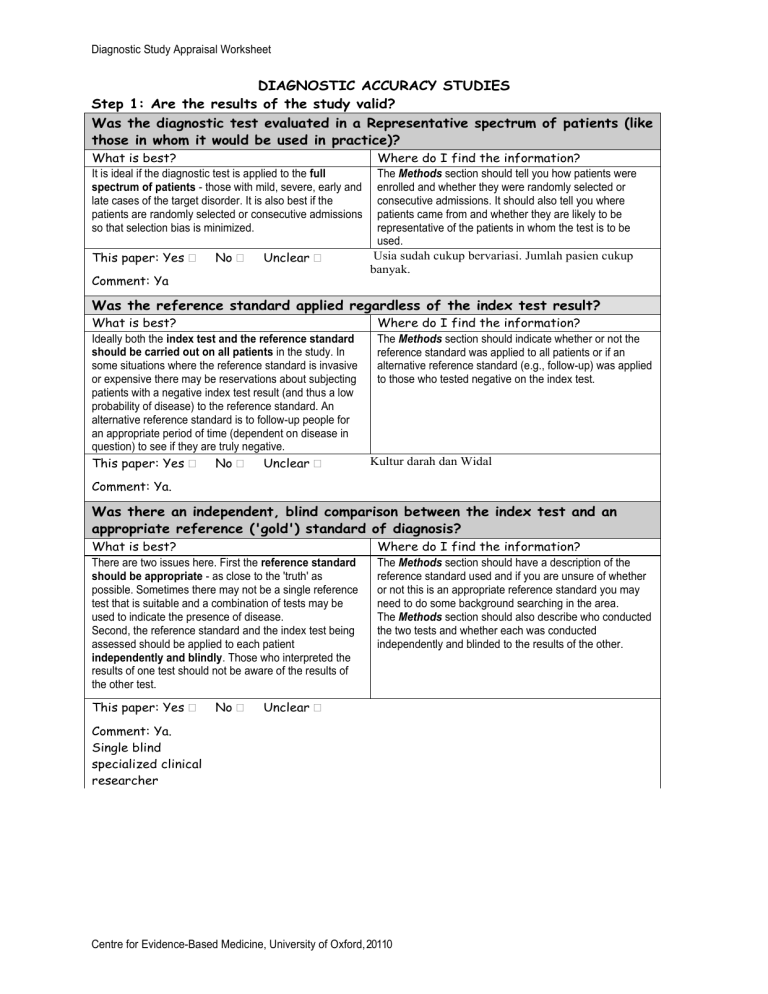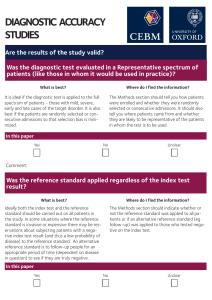
Diagnostic Study Appraisal Worksheet
DIAGNOSTIC ACCURACY STUDIES
Step 1: Are the results of the study valid?
Was the diagnostic test evaluated in a Representative spectrum of patients (like
those in whom it would be used in practice)?
What is best?
It is ideal if the diagnostic test is applied to the full
spectrum of patients - those with mild, severe, early and
late cases of the target disorder. It is also best if the
patients are randomly selected or consecutive admissions
so that selection bias is minimized.
This paper: Yes
No
Unclear
Comment: Ya
Where do I find the information?
The Methods section should tell you how patients were
enrolled and whether they were randomly selected or
consecutive admissions. It should also tell you where
patients came from and whether they are likely to be
representative of the patients in whom the test is to be
used.
Usia sudah cukup bervariasi. Jumlah pasien cukup
banyak.
Was the reference standard applied regardless of the index test result?
What is best?
Where do I find the information?
Ideally both the index test and the reference standard
The Methods section should indicate whether or not the
should be carried out on all patients in the study. In
reference standard was applied to all patients or if an
some situations where the reference standard is invasive
alternative reference standard (e.g., follow-up) was applied
or expensive there may be reservations about subjecting
to those who tested negative on the index test.
patients with a negative index test result (and thus a low
probability of disease) to the reference standard. An
alternative reference standard is to follow-up people for
an appropriate period of time (dependent on disease in
question) to see if they are truly negative.
Kultur darah dan Widal
This paper: Yes No Unclear
Comment: Ya.
Was there an independent, blind comparison between the index test and an
appropriate reference ('gold') standard of diagnosis?
What is best?
There are two issues here. First the reference standard
should be appropriate - as close to the 'truth' as
possible. Sometimes there may not be a single reference
test that is suitable and a combination of tests may be
used to indicate the presence of disease.
Second, the reference standard and the index test being
assessed should be applied to each patient
independently and blindly. Those who interpreted the
results of one test should not be aware of the results of
the other test.
This paper: Yes
No
Where do I find the information?
The Methods section should have a description of the
reference standard used and if you are unsure of whether
or not this is an appropriate reference standard you may
need to do some background searching in the area.
The Methods section should also describe who conducted
the two tests and whether each was conducted
independently and blinded to the results of the other.
Unclear
Comment: Ya.
Single blind
specialized clinical
researcher
Centre for Evidence-Based Medicine, University of Oxford, 20110
Diagnostic Study Appraisal Worksheet
Step 2: What were the results?
Are test characteristics presented?
There are two types of results commonly reported in diagnostic test studies. One concerns the accuracy of the test and
is reflected in the sensitivity and specificity. The other concerns how the test performs in the population being tested and
is reflected in predictive values (also called post-test probabilities). To explore the meaning of these terms, consider a
study in which 1000 elderly people with suspected dementia undergo an index test and a reference standard. The
prevalence of dementia in this group is 25%. 240 people tested positive on both the index test and the reference
standard and 600 people tested negative on both tests. The first step is to draw a 2 x 2 table as shown below. We are
told that the prevalence of dementia is 25% therefore we can fill in the last row of totals - 25% of 1000 people is 250 - so
250 people will have dementia and 750 will be free of dementia. We also know the number of people testing positive
and negative on both tests and so we can fill in two more cells of the table.
Reference Standard
+ve
-ve
240
Index test
+ve
600
-ve
250
750
1000
By subtraction we can easily complete the table:
Reference Standard
+ve
-ve
240
150
Index test
+ve
390
10
600
-ve
610
250
750
1000
Now we are ready to calculate the various measures.
What is the measure?
What does it mean?
Sensitivity (Sn) = the proportion of people with the
The sensitivity tells us how well the test identifies people with
condition who have a positive test result.
the condition. A highly sensitive test will not miss many people.
In our example, the Sn = 240/250 = 0.96
10 people (4%) with dementia were falsely identified as not
having it. This means the test is fairly good at identifying people
with the condition.
Specificity (Sp) = the proportion of people without
the condition who have a negative test result.
The specificity tells us how well the test identifies people
without the condition. A highly specific test will not falsely
identify many people as having the condition.
In our example, the Sp = 600/750 = 0.80
150 people (20%) without dementia were falsely identified as
having it. This means the test is only moderately good at
identifying people without the condition.
Positive Predictive Value (PPV) = the proportion of
people with a positive test who have the condition.
This measure tells us how well the test performs in this
population. It is dependent on the accuracy of the test
(primarily specificity) and the prevalence of the condition.
Of the 390 people who had a positive test result, 62% will
actually have dementia.
In our example, the PPV = 240/390 = 0.62
Negative Predictive Value (NPV) = the proportion
of people with a negative test who do not have the
condition.
This measure tells us how well the test performs in this
population. It is dependent on the accuracy of the test and the
prevalence of the condition.
In our example, the NPV = 600/610 = 0.98
Of the 610 people with a -ve test , 98% will not have dementia.
ASSESSMENT OF ELISA FOR THE DIAGNOSIS OF TYPHOID FEVER
TH
1371
TH + TH Index + 108
129
237
Index - 203
931
1134
311
1060
Centre for Evidence-Based Medicine, University of Oxford, 20120
Diagnostic Study Appraisal Worksheet
Sensitivitas TH: 108/311 = 0.34
Spesifisitas TH: 931/1060 = 0.87
PPV TH: 108/129
NPV TH: 931/1134
Anti TO
1371
Index +
Index -
TO +
104
194
298
TO 133
940
1073
1371
Index +
Index -
IGM +
193
IGM 44
1371
Index +
Index -
IGG +
193
IGG 44
237
1134
Sensitivitas TO: 104/298 =
Spesifisitas TO: 940/1073 =
PPV TO: 104/133
NPV TO: 940/1134
IGM
237
1134
Sensitivitas igM: 193/ =
Spesifisitas igM:
IGG
237
1134
Sensitivitas igM: 193/ =
Spesifisitas igM:
Step 3: Applicability of the results
Were the methods for performing the test described in sufficient detail to
permit replication?
What is best?
The article should have sufficient description of the test to
allow its replication and also interpretation of the results.
This paper: Yes
No
Where do I find the information?
The Methods section should describe the test in detail.
Unclear
Comment: Ya
Centre for Evidence-Based Medicine, University of Oxford, 20130
Diagnostic Study Appraisal Worksheet
Centre for Evidence-Based Medicine, University of Oxford, 20140
